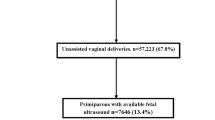Abstract
Objective
Fetal malposition, specifically occiput posterior and transverse (OP/OT), is associated with higher intra-partum morbidity. We tested the hypothesis that young maternal age and pelvic immaturity are risk factors for fetal malposition.
Methods
In a cohort study of all nulliparous teen (≤18 years) deliveries over a 4-year period at one institution, fetal head position at time of delivery was collected and correlated with maternal characteristics and outcome data. Using Risser staging observations, pelvic maturity age was set at 16, and accordingly, the women were divided into two groups (younger vs. older teens). Analysis was performed using Fisher’s exact, student t test, and logistic regression modeling.
Results
Older teen mothers (16–18 years, n = 609) had higher rates of malposition (22 vs. 12 %, p = 0.02) when compared with younger teens (≤15 years, n = 98). Among all women with a malpositioned fetus, older teens had a higher body mass index (BMI: 32.6 ± 6.7 vs. 28.5 ± 3.5, p = 0.04) and subsequent need for cesarean delivery (69 vs. 33 %, p = 0.02) when compared with their younger counterparts. Although younger teens were more successful in having a vaginal delivery (67 %) with an OP/OT position, it was at the expense of a 25 % rate of severe perineal laceration (third/fourth degree).
Conclusion
Obesity, and not young maternal age or pelvic immaturity, is associated with fetal malposition. The direct association with increasing pre-pregnancy BMI and the long-term impacts of the high rates of cesarean delivery in this young population underscores the need for more public health focus.

Similar content being viewed by others
References
Haeri S, Guichard I, Baker AM, Saddlemire S, Boggess KA (2009) The effect of teenage maternal obesity on perinatal outcomes. Obstet Gynecol 113(2):300–304
Goldberg RL, Klerman LV (1995) Adolescent pregnancy-another look. N Engl J Med 332:1161–1162
Fraser AM, Brockert JE, Ward RH (1995) Association of young maternal age with adverse reproductive outcomes. N Engl J Med 332:1113–1117
Ponkey SE, Cohen AP, Heffner LJ, Lieberman E (2003) Persistent fetal occiput posterior position: obstetric outcomes. Obstet Gynecol 101(5 Pt 1):915
Cheng YW, Shaffer BL, Caughey AB (2006) Associated factors and outcomes of persistent occiput posterior position: a retrospective cohort study from 1976 to 2001. J Matern Fetal Neonatal Med 19(9):563
Floberg J, Belfrage P, Ohlsén H (1987) Influence of the pelvic outlet capacity on fetal head presentation at delivery. Acta Obstet Gynecol Scand 66(2):127
Risser JC (1958) The iliac apophysis: an invaluable sign in the management of scoliosis. Clin Orthop 11:111–119
Hoppenfeld S, Lonner B, Murthy V (2003) The rib epiphysis and other growth centers as indicators of the end of spinal growth. Spine 29:47–50
Modi HN, Modi CH, Suh SW, Yang JH, Hong JY (2009) Correlation and comparison of Risser sign versus bone age determination (TW3) between children with and without scoliosis in Korean population. J Orthop Surg Res 4:36
Gardberg M, Laakkonen E, Sälevaara M (1998) Intrapartum sonography and persistent occiput posterior position: a study of 408 deliveries. Obstet Gynecol 91:746
Peregrine E, O’Brien P, Jauniaux E (2007) Impact on delivery outcome of ultrasonographic fetal head position prior to induction of labor. Obstet Gynecol 109:618
Le Ray C, Carayol M, Jaquemin S (2005) Is epidural analgesia a risk factor for occiput posterior or transverse positions during labour? Eur J Obstet Gynecol Reprod Biol 123:22
Lieberman E, Davidson K, Lee-Parritz A, Shearer E (2005) Changes in fetal position during labor and their association with epidural analgesia. Obstet Gynecol 105:974
Conflict of interest
We declare we have no conflict of interest.
Author information
Authors and Affiliations
Corresponding author
Rights and permissions
About this article
Cite this article
Haeri, S., Baker, A.M. Estimating the impact of pelvic immaturity and young maternal age on fetal malposition. Arch Gynecol Obstet 286, 581–584 (2012). https://doi.org/10.1007/s00404-012-2345-z
Received:
Accepted:
Published:
Issue Date:
DOI: https://doi.org/10.1007/s00404-012-2345-z




